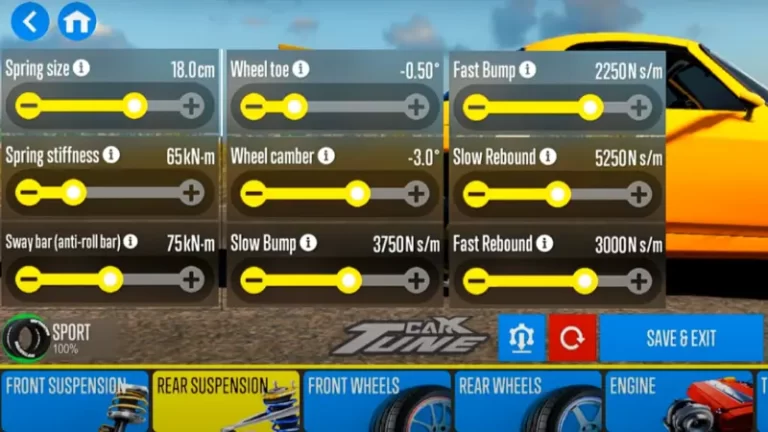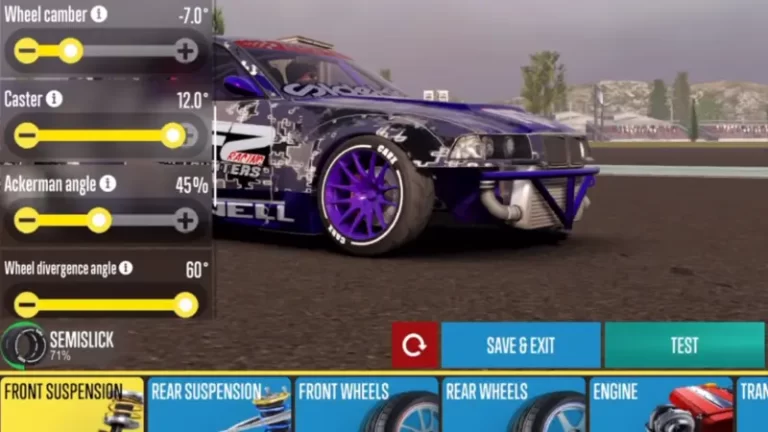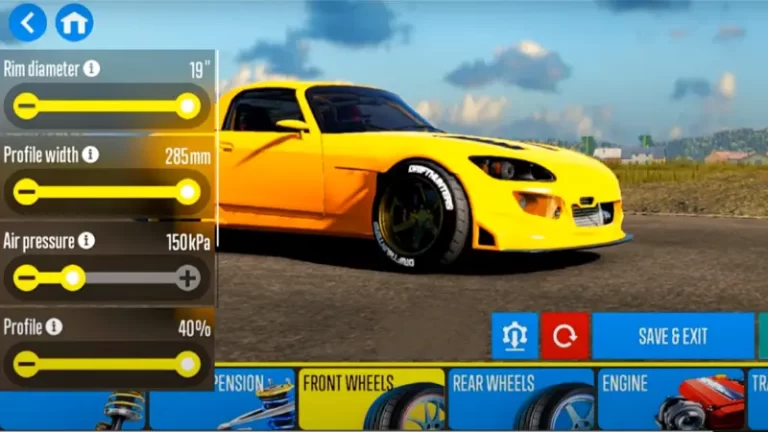CarX Drift Racing 2 Tuning Guide – Tips To Tune-Up Your Car

In the adrenaline-fueled world of CarX Drift Racing 2, tuning your car to perfection is the key to unlocking its true potential. Whether you’re a seasoned drifter or a novice just starting out, mastering the art of car tuning will elevate your performance and allow you to dominate the virtual racetracks.
In this comprehensive tuning guide we will explore various aspects of tuning that will equip you with the knowledge and techniques to transform your vehicle into a drifting masterpiece.
Tuning Basics
Tuning paly a pivotal role in tapping your vehicle’s capabilities to the fullest and achieving optimal performance on the virtual racetracks. It involves adjusting various parameters to optimize performance, stability, and control.
Lets explore together the fundamental aspects of tuning:
Decoding The Language Of Suspension Tuning
Suspension plays a pivotal role in determining your car’s handling and stability, making it a crucial element of tuning. The goal is to achieve a balance between stiffness and responsiveness, ensuring that your car can navigate corners with precision while maintaining control at high speeds.

Spring Size
The distance between the car’s chassis and the ground, influences the overall center of gravity. Lowering the ride height can improve handling and stability, but it’s essential to strike a balance to avoid bottoming out or compromising suspension travel.
Spring Stiffness
Spring stiffness affects the car’s response to bumps and changes in road surface. Stiffer suspension provides better control and reduces body roll during cornering, but it can also make the ride harsher and reduce traction on uneven surfaces.
To elaborate further, for cars with high horsepower and having engine on front (as majority of cars in this game) keep medium stiffness in the front springs and low in the back.
Sway Bars
Sway bars, also known as anti-roll bars, help to reduce body roll during cornering by transferring weight to the opposite side of the car. Adjustable sway bars allow you to fine-tune the car’s handling characteristics, making it more responsive or more stable depending on your preferences. For over-steer case keep high value in front and low value in the back & for under-steer keep front soft and back stiffer.
Damper Settings
Damper settings control the speed at which the suspension compresses and rebounds. Damping affects the car’s ability to absorb bumps and maintain contact with the road, influencing both handling and ride comfort.
Slow Bump: Slow bump value defines weight shift from driver’s input (this includes braking, accelerating and so forth.) A high value will increase the car’s resistance and result in slower reaction and lower values will reduce the resistance and cause faster reaction. Too high or low values will result in traction loss.
Fast Bump: Fast bump has the same working principle as slow bump but this works mainly for fast transfer of weight such as when driving on bumpy tracks.
Wheel Toe
Wheel Toe adjustment is done on the wheels to affect the vehicle’s overall handling. Wheels facing outwards is toe-out/negative toe and wheels facing inside is toe-in/positive toe.
Generally, you should have a positive wheel toe value in the front and a negative one in the back.
Wheel Camber
The inward or outward tilt of wheels is called the wheel camber. When the wheel’s are perfectly perpendicular to the road it is zero degrees camber. For increasing the car’s grip at large drift angles an outward tilt is used. Use zero values for achieving maximum grip on a straight line, while slightly negative values allow for more grip when cornering.
Caster
Caster angle assists in car stabilization. Increasing caster angle give quick steering response/stability on high speed corners and can give some extra traction in the corners. Avoid excessive positive values, as it will result in a loss of grip of the front wheels. On negative caster values the car will be under braking and unstable. Zero caster values result in easy steering and quick tire traction response on corners.

Ackerman Angle
The Ackerman angle setting should be adjusted based on the car’s power and its steering angle. While cornering, drift speed and trajectory will increase by using a positive Ackerman value but will result in making steering harder too.
Wheel Divergence Angle
Also called wheel divergence angle. Higher steering value means a larger drift angle. Keep the value close to max but keeping in mind the Ackerman angle.
Unlocking The Secrets Of Wheels Tuning
Wheel setup are essential for achieving optimal grip and handling. The right wheel tuning can transform your car’s performance, allowing you to execute drifts with precision and control.

Rim Diameter
Bigger diameter car wheels causes more traction thus requiring more power to spin them. Smaller rim diameter provide easier drift start as they give more acceleration and more turning precision.
Tire Width
Wider tires generally provide more grip, but they can also increase rolling resistance and affect overall handling. In case of understeering, increase the rear tires width or decrease the front tires width. For oversteering, simply reverse the procedure.
Tire Pressure
Tire pressure can significantly impact grip and handling. Lower air pressure means more grip but too low will slow down the car, Find the right value that is balanced and gives best results. In case of oversteer it is suggested to increase the front tires air pressure than the rear tires. Apply opposite in case of understeer.
Tire Profile
The lower the tire profile value be, the more the overall grip and control you will have over your car. Usually, keep it around 30%.
Brakes
In this section we will discuss the adjustments for the brakes:
Brake Torque
It is the force applied to brakes. A higher value means the faster the vehicle will stop.
Front Brake Bias
This is the percentage of braking force that is applied to the front wheel. It affects the vehicle behavior during braking while cornering. Of course, it depends on your driving style. but setting this value too high can make the car understeer. Higher front brake bias mean that the front wheels will do more to stop the car, than the rear wheels.
Conclusion
Mastering the art of drifting in CarX Drift Racing 2 requires a combination of car tuning expertise, refined driving technique, and unwavering determination.
There is no one standard-set up that can work for every car or driving style in CarX Drift Racing 2. Once you understand the purpose and affect of each setting on the vehicle, you can adjust it to fit your preferred driving style.
By carefully adjusting your car’s suspension, engine, aerodynamics, and tires, you can optimize its performance and unleash its full potential.
Simultaneously, honing your driving skills, particularly weight transfer, throttle control, and handbrake usage, will enable you to execute precise and controlled drifts. With dedication and practice, you can elevate your drifting prowess (click to learn Tips and Tricks of playing CarX Drift Racing 2), conquer the virtual racetracks, and etch your name among the ranks of CarX Drift Racing 2 legends.
Frequently Asked Questions:
Related Post

